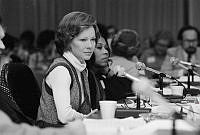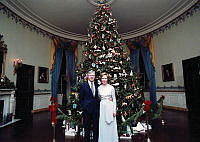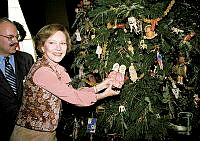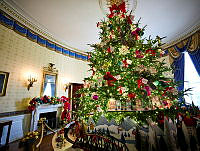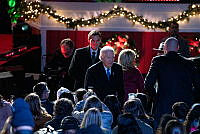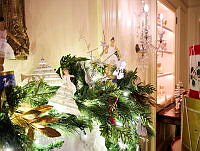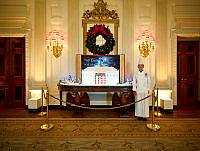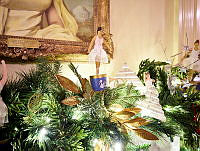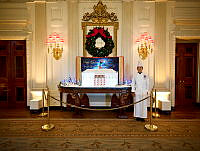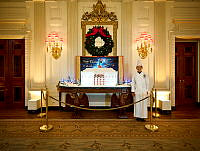The White House Social Secretary
Copyright © White House Historical Association. All rights reserved under international copyright conventions. No part of this article may be reproduced or utilized in any form or by any means, electronic or mechanical, including photocopying, recording, or by any information storage and retrieval system, without permission in writing from the publisher. Requests for reprint permissions should be addressed to books@whha.org
The White House Historical Association began an oral history project in 2010 under the guidance of Maria Downs, the Association’s public affairs director and the White House Social Secretary during the Gerald Ford administration. Ms. Downs recognized that important insights into White House history were slipping away with the passing of social secretaries. They rarely wrote or spoke of their experiences and relationships with the presidents and first ladies. Presidential historian Richard Norton Smith was invited to serve as a consultant and interviewer for the project and over the past several years has completed fourteen in depth video interviews.
This presentation is the first of an unfolding series of web presentations and digital archival materials related to the history of White House Social Secretaries. These materials will be made available as part of the David M. Rubenstein Center for White House History. From the intricacies of protocol to routine office work, the social secretary must possess unfailing tact in knowing how to greet and communicate with people who wish to request things from or time with the president and first lady. Learning to say “no” at the White House is an art form—softened, changed, and used when possible with every negative except the hard small bullet of the word. President Calvin Coolidge's social secretary Mary Randolph once described the qualities needed for the position: “The White House Secretary should combine keen perceptions and sensibilities with the strength of Hercules, the hide of a rhinoceros, great endurance and a sense of humor.”

First Lady Betty Ford, President Gerald Ford, and Social Secretary Maria Downs in the Blue Room at the White House dinner for members of the Federal Judiciary on November 24, 1975.
Gerald R. Ford Presidential Library and Museum/NARAOrigins of the Position of White House Social Secretary
The position of White House Social Secretary traces its origins to the employment of Isabella Hagner as a salaried executive clerk assigned to First Lady Edith Roosevelt in 1901. Before that time male clerks in the president’s office assumed the duties of correspondence, invitation lists, seating charts, floral decorations, and menus usually under the direction of a presidential aide. At the end of the nineteenth century, Colonel Theodore Bingham, an aide and the officer in charge of public buildings and grounds, had become the major domo at the White House and keeper of the social lists. In 1903, newspapers declared a “social war” had broken out at the White House, and, with Edith Roosevelt’s strong backing, Hagner “went after Bingham with a meat ax” and “he got his walking papers.”
Earlier, Bingham’s ambitions to direct a major renovation of the White House ran afoul of Mrs. Roosevelt. The Roosevelts consulted with the New York firm of McKim, Mead and White in 1902 to develop plans for doubling the space allocated to the family living quarters, providing a new wing for the president and his staff, and a new area on the east for receiving guests. Bingham attempted to block the plans, but the White House complex today largely reflects the influence of the “Roosevelt restoration.” Bingham held a grudge against the new White House as his influence waned and he became imperious and imprudent. It would be his downfall. Social events at the White House were now run entirely from the family quarters of the second floor.

The White House social secretary position traces its origins to the employment of Isabella Hagner as a salaried executive clerk assigned to First Lady Edith Roosevelt.
Collection of the Hagner familyPrecedents Set by the Theodore Roosevelt Administration
The newspapers in the early twentieth century often portrayed Belle Hagner as “arbiter of White House social affairs” or the “real social ruler at the White House.” In reality, the changes to the social functions at the White House were a part of a larger reorganization of the house. President Theodore Roosevelt established the position of chief usher, an organizational chart for the 57 people working in and around the White House, and assigned a military aide to assist the president and first lady for more complex tasks. Roosevelt also brought military aides to the White House and at social events had the young military officers bedecked in dress uniforms to provide flair to any social occasion.
The Roosevelts set precedents for glamour and spectacle in state entertainment and planned the White House wedding of the century when Alice Roosevelt married Nicholas Longworth in 1906. Teas and musicales for 200–600 and garden parties became a regular part of the Washington social scene. Belle Hagner created the guest lists, but Mrs. Roosevelt had the final say and determined to set the city’s social pace.

Eleanor Roosevelt is pictured with Malvina "Tommy" Thompson, middle, and Edith Benham Helm, right, at the White House in Washington, D.C., on April 1, 1941.
Franklin D. Roosevelt Presidential Library and Museum/NARAThe White House Social Secretary Becomes an Institution
For more than one hundred years, White House Social Secretaries have been individuals with a tenacity of purpose, loyal to the president and first lady, and a profound knowledge of protocol and society in Washington, D.C. As time passed first ladies naturally expanded the number of staff working on social events. First Lady Grace Coolidge retained Laura Harlan, social secretary in the Warren G. Harding administration, and added Mary Randolph to her staff to work on social events. First Lady Eleanor Roosevelt handled the vast social side of the Franklin D. Roosevelt White House with the assistance of her personal secretary, Malvina “Tommy” Thompson and Edith Benham Helm.
First ladies have had a social secretary and clerks on the government payroll, but the positions were not recognized as part of the institutionalized presidency until the Dwight D. Eisenhower administration. White House Social Secretary Mary Jane McCaffree was listed in the Congressional Directory's top White House personnel as "Acting Secretary to the President's Wife." Today, the social secretary also holds a position as a special assistant to the president.

First Lady Jacqueline Kennedy joins the U.S. Marine Band at a farewell party for Social Secretary Letitia Baldrige, left, on May 29, 1963.
John F. Kennedy Presidential Library and Museum/NARA



















